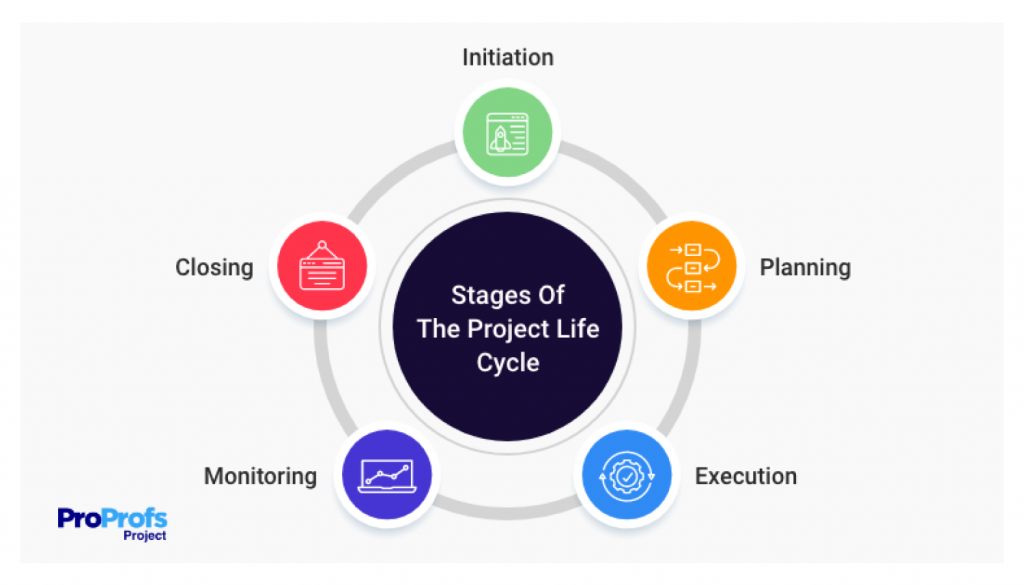As a project manager, the one mistake you should never make is letting the fate of a project lie in the hands of ‘the process.’ In other words, it’s a common misconception that the best way to execute a project is to figure things out as they come along.
Without a properly defined project plan, your team can end up confused, not knowing what to do, and the project can go haywire. Not exactly an ideal situation, right?
Project planning can help you avoid such situations.
This is where you promote transparency so that all stakeholders, sponsors, and team members know what’s on the list and how to execute it. Now, I understand that it may seem overwhelming, especially if you’ve just started as a team lead or manager.
But don’t worry, because by the time you finish reading this blog, you’ll be well prepared to manage projects like a professional.
What Is Project Planning?
Techopedia defines project planning as –
“…a procedural step in project management, where required documentation is created to ensure successful project completion.”
This ‘documentation’ includes all additional steps and actions required to plan the project successfully. The project plan must clearly define how the project should be executed, tracked, and wrapped up.
In fact, it is the second step in the lifecycle of a project, after the ‘project initiation’ phase.

Having a definite plan before starting a project acts like a treasure map. It ensures that you do not waste time and effort on elements like resource utilization, communication, etc., once the project execution phase kicks off.
How to Create a Project Plan: 8 Simple Steps
Before I share some of the best practices in a step-by-step manner, here’s a rule of thumb – make sure that the project plan is clear and provides clarity to your team.
That is a non-negotiable because, after the planning phase, the project moves to execution. And it’s not ideal to have too many changes/roadblocks as that can hinder deliverability. Let’s not get straight to the steps.
#1 Project Initiation: Securing the Go-Ahead
I know you’d probably be asking –
Hey, didn’t you say this comes in the project lifecycle as the phase before project planning?
Yes, that’s true. The only reason why I added it here is because, without initiating the project, it’s not possible to jump straight into the planning phase.
So, the initiation phase marks the formal commencement of the project. This typically involves creating a project charter. Think of it as securing buy-in from key decision-makers and officially setting the project in motion.
For a detailed read: Project Initiation: What Is the Right Way to Start a Project in 2024?
#2 Scope Definition: Keeping Your Focus
“What objectives are we trying to achieve?” – should be the first question in your mind when defining the scope and setting project objectives.
It’s crucial to grasp the scope of a project before you zero into it. This involves meticulously outlining the project’s deliverables (the final products or outcomes) and ensuring everyone is well aware of the boundaries.
A well-defined scope helps prevent scope creep, where additional features or tasks are introduced mid-project, causing delays and exceeding the budget.
Here are some additional questions I suggest discussing with stakeholders –
- What is the goal of your project?
- What are the main objectives that must be achieved?
- What are the deadlines for each objective?
- How involved would you like to be in the project?
- How would you like to measure the success of the project once completed?
Want to know more? Read this blog: Project Scope: How to Define & Manage It Like a Pro
#3 Develop a Work Breakdown Structure: Breaking Down the Big Tasks
Ever feel overwhelmed by a large project? It’s pretty common when you see big chunks of tasks staring back at you. At this point, the Work Breakdown Structure (WBS) comes to the rescue.
So, the third step of project planning and management involves dissecting the big tasks into smaller, more manageable subtasks.
This could involve tasks, like “designing the website layout” or “conducting market research.” The WBS is often visualized as a branching structure, resembling a tree – where the main project objective forms the trunk and the tasks branch out like limbs.
? Pro Tip: Spreadsheets are good. But if you want to break down tasks into subtasks, set dependencies, assign them, or prioritize important tasks without breaking a sweat, it’s recommended to get a task management tool.
#4 Resource Estimating: Knowing Who Does What
Resources are the fuel for your project engine. They can be people, equipment, technology, or anything else you need. Constraints, on the other hand, are the roadblocks or speed limits. They could be budgetary limits, time constraints, or resource availability.
Estimating resources is about determining the time and effort required for each task within the WBS. This considers the skills and expertise of your team members. It also includes the availability of team members so that no one is overburdened.
Needless to say, to plan resources effectively, you will need a resource management tool. Such a software solution will help you track all resources in one place, plan ahead with time tracking, estimate costs, generate invoices, and so on.
#5 Set a Realistic Timeline: Putting Time on Your Side
Now that you have tasks and resource estimates, it’s time to chart the course. This involves creating a timeline that reflects the project’s scope, resources, and deadlines.
Think of it as scheduling appointments in your calendar. And remember that it’s not just about setting dates; it’s about understanding task dependencies, critical paths, and milestones. Sometimes, I make things easier by using scheduling tools like Gantt charts to visually represent the project timeline.
Read more: How to Build a Project Timeline in 6 Simple Steps
#6 Cost Budgeting: Counting Every Penny
Every project has associated costs. Budgeting involves creating a detailed financial plan that outlines all the anticipated expenses throughout the project lifecycle.
This goes beyond just salaries – consider costs like software licenses, materials required for tasks (e.g., printing flyers for marketing), and potential travel expenses.
A realistic budget helps you ensure you have the necessary financial resources to complete the project successfully. It also reduces the chances of having sudden or unexpected budget-related surprises while the project is in the execution phase.
Need some tips to get started? No worries, here are some for you –
- Break down the project into individual tasks and estimate the cost for each, considering labor, materials, and other resources.
- Compile the estimated costs to create a budget, including a detailed account of all expected expenses.
- Set aside a contingency fund to cover unexpected costs or overruns, typically a percentage of the total budget.
- Regularly track actual spending against the budget and adjust as necessary to stay on track.
#7 Risk Management: Preparing for the Unexpected
“I bet nothing can go wrong! We planned it so religiously, after all.”
Does something like this go on your mind before starting a new project? If yes, then chances are you’re going to lose your sanity in the next few weeks (or as soon as the project deadlines appear).
You see, even the most thoroughly planned projects can encounter unforeseen challenges. This could be anything from unexpected technical issues to delays in receiving crucial materials.
What you can do here is reduce the blow by identifying potential risks early on, assessing their impact, and planning mitigation strategies. Here’s how –
- Conduct thorough risk assessments and engage with all stakeholders to understand different perspectives.
- Evaluate the impact of identified risks using tools like SWOT analysis, risk matrices, or Monte Carlo simulations.
- Arrange risks based on their severity and the urgency of addressing them.
- Create strategies for each risk, deciding whether to avoid, mitigate, accept, or transfer them.
Learn more about risk management here: How to Overcome Risks Using a Comprehensive Risk Management Plan
#8 Communication Plan Development: Keeping Everyone Informed
| “The more we learn about effective communication, the better we’ll be at leading, as our directives will be better understood.” – Paul Jarvis, author and designer. |
Communication should be seamless among people invested in the project’s outcome – team members, project managers, stakeholders, etc. This includes determining –
- Frequency: How often will updates be communicated? (e.g., Daily, weekly)
- Channels: What communication tools will be used? (e.g., Team meetings, project management software)
- Roles: Who is responsible for providing updates? (e.g., Project manager, team leads)
An effective communication plan ensures everyone knows what’s happening when it’s happening, and what changes might be on the horizon.
Although there are communication tools like Google Meet, Skype, and so on, I prefer team communication software more. The most obvious reason is that you can communicate and collaborate even when working, and you don’t need to switch platforms for menial stuff like tagging someone, adding comments, sharing files, and so on.
Read more: 10 Surefire Ways to Improve Team Communication
Why Is the Project Planning Phase so Crucial?
If you’re looking for a one-shot answer to this question, it will be – the project planning process is the bedrock upon which the entire project stands.
Here are some of the reasons why this phase in the project lifecycle is so important –
- Reduced Risk of Failure: Meticulous planning helps identify potential roadblocks and challenges before they derail your project. Anticipating risks and formulating mitigation strategies helps in proactively addressing issues and minimizing their impact.
- Clear Direction & Focus: The clarity you get after defining the project’s goals, scope, and deliverables ensures everyone involved is aligned on the project’s objectives and prevents scope creep.
- Improved Resource Allocation: This ensures you have the right people with the appropriate skills assigned to the relevant tasks and that necessary equipment or software is acquired beforehand.
- Enhanced Communication & Collaboration: When you create an effective communication plan, you ensure everyone is on the same page and gets updated whenever needed.
- Realistic Expectations & Timelines: Through effort estimation and task sequencing, project planning helps create a realistic schedule that prevents unrealistic deadlines and ensures project milestones are achievable.
- Cost Control & Budget Management: Budgeting allows you to anticipate and factor in all potential expenses and helps you stay within your financial constraints and avoid cost overruns.
- Increased Stakeholder Confidence: Clear goals, timelines, and resource allocation demonstrate a professional approach and inspire confidence in stakeholders – vital for securing buy-in.
Real-Life Examples of Project Planning
Now that you know almost everything about project planning steps and their importance, let’s check some examples of how a project plan may look in real life.
Example 1: Launching a Personal Website
Project Initiation:
- Define Goals:
- Website Purpose: Portfolio, blog, personal brand, etc.
- Target Audience: Who are you trying to reach?
- Desired Functionality: Contact form, eCommerce integration, etc.
Scope Definition:
- Content Structure: Static one-pager or dynamic blog with regular updates.
- Technical Features: Basic HTML/CSS or complex functionalities.
Develop the Work Breakdown Structure (WBS):
- Domain Registration: Secure a relevant domain name (e.g., yourname.com).
- Website Hosting: Choose a provider based on traffic expectations and features.
- Content Creation:
- Craft compelling text, images, and media relevant to your goals.
- Consider SEO optimization for better search engine visibility.
- Website Design & Development:
- DIY Approach: Utilize website builder platforms.
- Hired Professional: Collaborate with a web developer or designer to achieve a custom-tailored website matching your specific vision.
Activity Sequencing:
- Domain Registration & Hosting: Secure the foundation before proceeding.
- Content Creation: Develop content while the website is under construction.
- Website Design & Development: Implementation based on the chosen approach.
- Content Integration: Populate the website with prepared content.
- Testing & Launch: Rigorous testing across different devices and browsers before going live.
Resource Allocation:
- Technical Expertise: Evaluate your comfort level with website-building platforms.
- Budget: DIY options are generally cost-effective, while professional development incurs additional fees.
Budgeting:
- Factor in domain registration fees, website hosting costs, and potential web developer/designer charges.
- Consider additional expenses like stock photos or premium website themes.
Here, in this case, you may think a communication plan is not a must, as you are launching a personal website. But, you may still need to connect with your web developer/designer, which requires communication. Hence, it can’t be ignored.
Example 2: Creating a Landing Page for a New Product
Project Initiation:
- Goal Setting:
- Generate leads: Capture email addresses for future marketing efforts.
- Drive pre-orders: Encourage early product adoption through pre-purchase options.
- Build brand awareness: Introduce your new product to a wider audience.
- Target Audience: Identify your ideal customer profile. Understanding their demographics, needs, and pain points is crucial for crafting a compelling message.
Scope Definition:
- Content Focus: Determine the essential information visitors should see:
- Product description and key features.
- Value proposition: How does the product solve customer problems?
- Competitive advantages: What sets your product apart?
- Visuals: High-quality product images, explainer videos, or interactive elements can significantly enhance user engagement.
Develop the Work Breakdown Structure (WBS):
- Landing Page Design:
- Layout and User Interface (UI): Create a visually appealing and user-friendly interface that aligns with your brand identity.
- Content Creation: Develop compelling copy that highlights the product’s benefits and resonates with your target audience.
- Call to Action (CTA): A clear and concise prompt for visitors to take the desired action (e.g., sign up for email updates, pre-order the product).
- Technical Development:
- Ensure the landing page is mobile-friendly and optimized for different devices.
- Integrate conversion tracking mechanisms to measure the effectiveness of your campaign.
Activity Sequencing:
- Prioritize the development of core content outlining the product’s value proposition and features.
- Design and development can occur simultaneously, with ongoing communication to ensure alignment.
- Testing on various devices is crucial before launch to guarantee a seamless user experience.
Resource Allocation:
- Content Writer: Craft compelling product descriptions and website copy.
- Graphic Designer: Develop visually appealing elements that enhance the landing page.
- Web Developer: Implement the technical aspects of the landing page and ensure functionality.
- Marketing Specialist: Promote the landing page through targeted marketing campaigns.
Timeline Development:
- Establish deadlines for content creation, design completion, and website launch.
- Buffer in time for testing and addressing any technical issues.
Budgeting:
- Factor in costs associated with:
- Design and development fees (if outsourced).
- Content creation services (if applicable).
- Paid advertising campaigns to drive traffic to the landing page.
Communication Plan:
- Maintain clear communication amongst team members involved in design, development, and marketing.
- Regular progress updates and collaborative decision-making are essential for a successful launch.
Embrace Systematic Project Planning With ProProfs Project
To pave the way for the next phase, i.e., project execution – you need to ensure that you have a robust plan in place. Following my step-by-step project planning guide is likely to deliver results consistent with the expected project output. But, something that is more likely to increase your chances of success is…
Getting a project planning software like ProProfs Project.
But, why ProProfs Project?
It’s one of the many tools I have tried and tested and found to have the sensitive balance of clean UI, advanced features (resource management, reports, automation, etc.), and an affordable price.Talking about affordability, if you are looking for a free project planning software solution, you can consider it, too – thanks to its freemium plan. In my experience, I think it’s one of the decent platforms available targeted towards startups and SMBs. Test it yourself!
FREE. All Features. FOREVER!
Try our Forever FREE account with all premium features!





